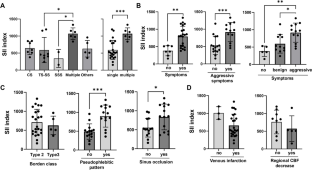Acta Neurochirurgica ( IF 2.4 ) Pub Date : 2024-04-16 , DOI: 10.1007/s00701-024-06075-1 Kota Kurisu , Toshiya Osanai , Yutaka Morishima , Masaki Ito , Haruto Uchino , Taku Sugiyama , Miki Fujimura

|
Purpose
The systemic immune-inflammation index (SII), a marker of systemic inflammation, can be calculated using peripheral blood tests. Although the SII has been reported as a feasible biomarker in various cerebrovascular diseases, no studies have explored in dural arteriovenous fistula (DAVF). A retrospective cohort study was performed to test whether the SII reflects the clinical characteristics of DAVF and whether this index could serve as a feasible biomarker.
Methods
This study included 28 patients who underwent endovascular treatment (39 sessions) for DAVF between 2014 and 2023. The SII was calculated using the following formula: platelet count multiplied by neutrophil count divided by lymphocyte count. We investigated the correlation between the SII and various clinical characteristics of DAVF, including symptom manifestation, and digital subtraction angiography findings. Additionally, we compared pre- and post-endovascular treatment changes in the SII.
Results
A significantly higher SII was observed in patients with multiple lesions, clinical symptoms (particularly aggressive symptoms), pseudophelebitic pattern (PPP), and sinus occlusion. Multivariate regression analysis revealed that the presence of symptoms (coefficient 270.9, P = 0.021) and PPP (coefficient 272.4, P = 0.017) were independent factors contributing to SII elevation. Notably, following endovascular treatment, there was a significant decrease in the elevated SII in patients whose symptoms resolved (P = 0.039) and where the DAVF was angiographically cured (P = 0.012).
Conclusion
Elevation of the SII in patients with advanced DAVF and its decrease following endovascular treatment suggests that the SII reflects the disease condition and indicates its potential as a promising biomarker.
中文翻译:

硬脑膜动静脉瘘的全身免疫炎症指数:反映其临床特征的可行生物标志物
目的
全身免疫炎症指数(SII)是全身炎症的标志,可以使用外周血测试来计算。尽管 SII 已被报道为各种脑血管疾病的可行生物标志物,但尚未有研究探索硬脑膜动静脉瘘 (DAVF)。我们进行回顾性队列研究来检验SII是否反映DAVF的临床特征以及该指标是否可以作为可行的生物标志物。
方法
该研究纳入了 2014 年至 2023 年间接受 DAVF 血管内治疗的 28 名患者(39 次)。SII 使用以下公式计算:血小板计数乘以中性粒细胞计数除以淋巴细胞计数。我们研究了 SII 与 DAVF 的各种临床特征之间的相关性,包括症状表现和数字减影血管造影结果。此外,我们还比较了血管内治疗前后 SII 的变化。
结果
在具有多个病变、临床症状(特别是侵袭性症状)、假性静脉炎模式(PPP)和鼻窦闭塞的患者中观察到显着较高的 SII。多元回归分析显示,症状的存在(系数270.9,P = 0.021)和PPP(系数272.4,P = 0.017)是导致SII升高的独立因素。值得注意的是,血管内治疗后,症状缓解( P = 0.039)和 DAVF 经血管造影治愈的患者升高的 SII 显着降低( P = 0.012)。
结论
晚期 DAVF 患者 SII 升高,而血管内治疗后 SII 降低,表明 SII 反映了疾病状况,并表明其作为一种有前途的生物标志物的潜力。



























 京公网安备 11010802027423号
京公网安备 11010802027423号